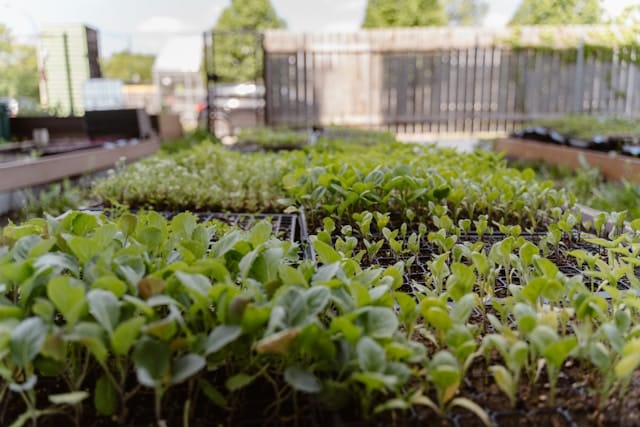With pressing global challenges like climate change, urbanization, and limited arable land, inside farming has emerged as a pioneering solution to support the world’s growing food needs. This innovative practice—ranging from small-scale indoor food growing systems to expansive vertical farms—offers a sustainable way to grow crops indoors. Inside farming leverages controlled environments to optimize light, temperature, and humidity, leading to improved yields and reduced resource use compared to traditional farming.
In this article, we explore 10 key innovations driving the growth of inside farming, examining how they impact food production, resource conservation, and even urban lifestyle. Each advancement represents a significant leap toward a sustainable future in food security, aiming to balance productivity with environmental responsibility.
The Core of Inside Farming Technology
Advanced Indoor Food Growing Systems
The success of inside farming relies on cutting-edge indoor food growing systems equipped with high-precision controls. These systems provide custom lighting, climate regulation, and automatic nutrient delivery based on real-time feedback from plant needs. They also include adaptable settings that allow the growth of various crops under a single roof, enhancing flexibility for diverse urban agriculture needs. By maintaining a fully enclosed system, these setups not only protect plants from pests and disease but also enable year-round production in both urban and rural areas.
Innovative Hydroponic and Aquaponic Methods
Hydroponics is a game-changer in inside farming due to its water efficiency and suitability for densely populated urban settings. Hydroponic systems deliver nutrient-rich water directly to the plant roots, drastically reducing water waste and eliminating the need for soil. An offshoot of hydroponics, aquaponics pairs fish farming with plant cultivation. Fish waste fertilizes the plants, and plants, in turn, clean the water for the fish. This mutually beneficial ecosystem showcases a powerful example of closed-loop systems, a hallmark of sustainable inside farming.
Vertical Farming: Maximizing Urban Space
With cities facing unprecedented growth, traditional horizontal farms are less feasible within urban environments. Vertical farming in inside farming stacks plants in layers, maximizing available space while creating ideal growth conditions. This setup integrates LED lighting to substitute sunlight, allowing plants to photosynthesize even in enclosed spaces. Vertical farming optimizes spatial efficiency, making it a practical solution for growing a high density of crops in urban areas where space is at a premium.
Technological Advances in Inside Farming
Automated Precision Agriculture and AI Integration
Inside farming’s reliance on automation and artificial intelligence (AI) has significantly increased, allowing for precise control over environmental factors. AI-powered sensors monitor and adjust climate settings in real-time, from temperature to humidity and nutrient levels. This automation reduces human error and optimizes the environment for each plant’s requirements, helping farmers achieve consistent, high-quality yields. Precision agriculture also uses data analytics to improve crop yields over time, utilizing predictive algorithms to anticipate and address growth issues.
Energy-Efficient LED and Quantum Dot Lighting
Lighting is crucial in inside farming; plants grown indoors require the full spectrum of light that mimics sunlight. Quantum dot LEDs, the latest innovation, produce an ideal light spectrum for photosynthesis while using minimal energy. These LEDs adapt to different growth stages, providing red and blue light wavelengths during early growth and full-spectrum light as plants mature. With LED efficiency on the rise, indoor farming facilities reduce their energy consumption while optimizing growth conditions, making the process more sustainable.
Sustainable Building Design for Inside Farming Facilities
Sustainable architecture plays a vital role in the eco-friendly advancement of inside farming. Building materials made from recycled sources, energy-efficient HVAC systems, and renewable energy sources, like solar panels, contribute to the carbon neutrality of indoor farms. Many facilities incorporate these elements to create green buildings that support the entire farming operation. Urban settings now see indoor farms integrated into mixed-use buildings, reducing transportation costs, and directly supplying local food markets.
Environmental Benefits of Inside Farming
Resource Efficiency: Reducing Water and Soil Use
Traditional farming consumes vast amounts of water and often leads to soil degradation. Inside farming, by contrast, minimizes water usage through hydroponic and closed-loop systems that recycle water. Indoor farming systems conserve up to 95% more water than conventional outdoor farms and eliminate soil erosion risks. This water efficiency is especially vital in areas where fresh water is scarce, presenting a sustainable alternative to traditional agricultural practices.
Reduced Carbon Footprint Through Urban Production
Urban-based inside farming significantly cuts down the distance food travels from farm to table, reducing carbon emissions from transportation. By producing food closer to consumers, this system supports a more localized food supply chain, minimizing energy costs associated with shipping and refrigeration. Additionally, because indoor farms are not weather-dependent, they avoid the costly resource inputs that traditional farms need to mitigate climate impacts.
Social and Economic Impact of Inside Farming
Employment Opportunities and Skill Development
As the indoor farming industry grows, so does the demand for skilled professionals trained in areas like horticulture, engineering, and data science. Inside farming creates diverse job opportunities, from farm managers and hydroponic system technicians to AI specialists who manage automated crop monitoring. Urban farms located within communities also contribute to local economies, providing fresh produce and offering educational programs to engage community members in sustainable agriculture.
Combating Food Deserts and Improving Food Security
Food deserts—urban areas lacking access to affordable fresh produce—pose a significant public health challenge. Inside farming addresses this issue by placing farms directly within cities and communities, bringing nutritious food closer to underserved populations. These farms reduce dependency on long-distance supply chains, ensuring communities have steady access to locally grown, high-quality produce, regardless of weather or season.
Future Innovations and Trends in Inside Farming
- AI-Driven Crop Analysis and Customization
AI plays a vital role in the future of inside farming by helping farmers customize growing conditions for specific crops. AI-driven analytics can assess nutrient content, predict yields, and even suggest the best growth strategies based on weather patterns and plant needs. This degree of customization will further optimize crop production, resulting in higher-quality food that meets the specific demands of consumers.
- CRISPR and Genetic Engineering in Crop Improvement
As genetic editing technologies like CRISPR become more advanced, there’s potential to develop crops that thrive under indoor conditions, offering higher yields and resistance to indoor farming-specific pests or diseases. By modifying crops to make them more compatible with inside farming systems, scientists aim to create plants that require even fewer resources and deliver better yields, improving food security without compromising environmental sustainability.
Challenges in Scaling Inside Farming
- Managing High Energy Requirements
Despite the efficiency of LED lighting, inside farming facilities require substantial energy inputs, especially in colder regions where heating is necessary. To reduce reliance on non-renewable energy, many indoor farms are turning to alternative power sources, like solar and wind. However, until renewable energy technology becomes more widely accessible and affordable, managing energy costs will remain a challenge for large-scale inside farming operations.
- Navigating Regulatory Hurdles
Regulatory compliance is an ongoing challenge, as most agricultural regulations are designed for traditional farming. Inside farming introduces new variables, from lighting and building codes to water usage policies, which existing laws may not fully address. Developing standardized guidelines for indoor farming practices will be crucial as the industry grows, ensuring that all facilities operate safely and sustainably.
- High Setup Costs for Large-Scale Facilities
Establishing an indoor farm involves significant initial costs due to the need for high-tech equipment, climate control systems, and specialized LED lighting. While the long-term benefits and reduced operational costs of inside farming often justify the initial expense, financial support through grants or partnerships may be necessary to make this technology more accessible on a larger scale.
Inside Farming and the Path to Global Food Security
Inside farming offers the potential to transform global food systems, creating more resilient, adaptable, and sustainable methods of growing food. By localizing food production, inside farming has the power to alleviate pressures on the environment, stabilize food prices, and mitigate food insecurity in vulnerable regions. This method represents a promising approach to meeting the needs of a rapidly growing population without compromising natural resources or harming ecosystems.
Conclusion
In conclusion, inside farming is not merely a trend; it’s a fundamental shift in how we produce and consume food. With advancements in hydroponics, vertical farming, automation, and sustainable building design, inside farming can produce fresh, nutritious food while reducing our reliance on traditional agricultural systems that often stress the environment. While challenges exist, the benefits of this innovative practice are undeniable. From local food production to reduced environmental impact, inside farming could be the key to a more sustainable, food-secure future.






